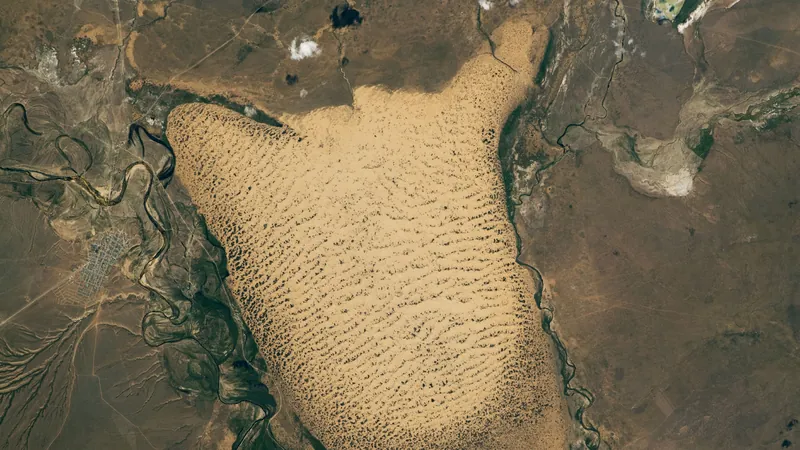
Unveiling the Mysteries of Kazakhstan's Giant 'Slug' Dunes: Nature's Frozen Marvel?
2025-09-02
Author: Rajesh
A Stunning Celestial View
Astronauts have captured an astonishing photograph of Kazakhstan's unique landscape, where a massive field of dunes forms a shape reminiscent of a giant slug slithering across the earth. This captivating formation appears to be gradually succumbing to nature’s grip, as vegetation clusters suggest that the sands are becoming increasingly stable.
Where Nature Takes Center Stage
Situated about 175 miles (280 kilometers) northeast of the Caspian Sea, this striking dune field lies in the western stretches of the Kazakh Steppe—an expansive area filled with open grasslands that stretches across northern Kazakhstan and parts of Russia. It is positioned between the village of Oyyl to the west and a sprawling floodplain to the east.
A Giant Among Us
Spanning approximately 75 square miles (190 square kilometers)—nearly three times the size of Manhattan—this gigantic ‘slug’ measures around 13 miles (21 km) at its widest point, as noted by NASA's Earth Observatory.
How Did This Marvel Form?
Dune fields like this one emerge in natural depressions known as sinks—typically found in windy regions where sand can accumulate. This particular sink is situated about 300 feet (90 meters) below the elevation of the surrounding terrain, creating a dramatic contrast in the landscape.
The Sands of Time
Most of the sand in this extraordinary formation originates from nearby floodplains, where drying conditions scatter previously trapped coarse sediments that the wind then carries away. National Geographic notes that the dynamics of these floodplains play a crucial role in generating the sands that give this 'slug' its shape.
Nature's Sculptor
The visible parallel lines across the dunes are indicators of sand ridges formed as the prevailing winds push sand in a northward direction, causing their positions to subtly shift over time.
A Blooming Landscape?
Dark patches across the dune field reveal clusters of plants that have taken root within the sand ridges. If these plants proliferate sufficiently, they may anchor the shifting sands, effectively freezing some areas in place—similar to certain coastal dunes found across the globe.
The Role of Water
Most vegetation is concentrated along the southern and western edges of the dune field, likely due to the influence of the Uil River, which meanders around Oyyl. This natural water source contributes to the lushness that thrives amid the arid sands.
The Future of Earth's Dune Field
Scientists remain intrigued about the future of the dune field. Will the creeping plant life eventually dominate and stabilize the entire area, or will the sands continue their slow dance across the landscape? The answer remains elusive, but the sight of this natural wonder is sure to spark curiosity and admiration for years to come.

 Brasil (PT)
Brasil (PT)
 Canada (EN)
Canada (EN)
 Chile (ES)
Chile (ES)
 Česko (CS)
Česko (CS)
 대한민국 (KO)
대한민국 (KO)
 España (ES)
España (ES)
 France (FR)
France (FR)
 Hong Kong (EN)
Hong Kong (EN)
 Italia (IT)
Italia (IT)
 日本 (JA)
日本 (JA)
 Magyarország (HU)
Magyarország (HU)
 Norge (NO)
Norge (NO)
 Polska (PL)
Polska (PL)
 Schweiz (DE)
Schweiz (DE)
 Singapore (EN)
Singapore (EN)
 Sverige (SV)
Sverige (SV)
 Suomi (FI)
Suomi (FI)
 Türkiye (TR)
Türkiye (TR)
 الإمارات العربية المتحدة (AR)
الإمارات العربية المتحدة (AR)